| |
RAUHA (PEACE)
music Witness® at the
20th Tampere, Finland Jazz Happening—2001
by Jeff Schlanger
January 2002
The Tampere Jazz Happening celebrated its 20th anniversary with a
beautifully coordinated manifestation of how people can listen to
each other and create awareness of new harmonics in human social possibilities.
If ever there was a time for a brilliant gathering of live music from
different countries, it was in these days and nights of world war
and threats of retribution. Apprehension, grief, and rage were like
incense fogging the airports, while ignorance, violence, and letters
of disease were spread through the usual channels of public communication.
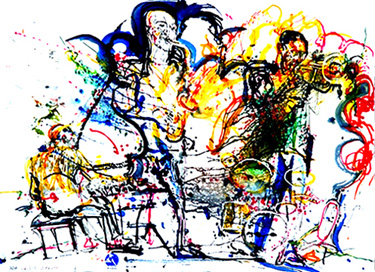 |
| Ash Crisis |
On Friday night, November 2nd, Andrew Bemkey's piano began
to rumble through the deep tones of downtown New York's Ash Crisis,
picked up by eager ears in Geoff Mann's drums. Roy Campbell's
incandescent trumpet force set off the eastern cry in leader Ori
Kaplan's alto saxophone. The intense sound of New York right
now was being delivered live and indelibly to an eager international
gathering downtown in Tampere.
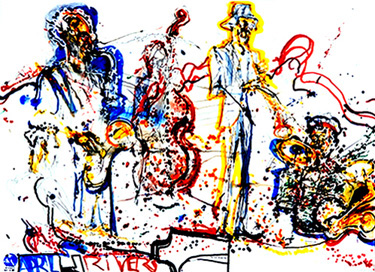 |
|
April Rivers |
Then Sam Rivers' Trio with Doug Mathews and Anthony
Cole opened out musical patterns from the leader's highly developed
angles on soprano, tenor, flute and piano. Flowing on through his
70's, Rivers is just as slim, erect, focused, and fiery as he was
through those intense nights on Bond Street in Studio Rivbea back
in 1976 when the music Witness® Project was just getting underway.
Concerts, workshops, and festivals put on there independently by the
Rivers family eventually led many of the participating musicians (for
instance David Murray, Wadada Leo Smith, Oliver Lake, Andrew Cyrille,
Fred Hopkins, Arthur Blythe…) to perform all over the world
including here in Tampere. The situation Sam Rivers creates with this
music and vision remains an open, moving, and lasting inspiration.
Saturday afternoon, Annie Gosfield kicked off her ball-heeled
wedgies, toed the electronic pedals of her sampling synthesizer, and
eased into the strange tones defining the vast industrial sonic space
of EWA7, the creation she premiered in a factory in Nürnberg
two years ago. Guitarist Roger Kleier, having warmed up his
steel on some Mississippi delta glissandos, slid far out as percussion
colormaster Jim Pugliese moved exuberantly from mallets on
gongs, cymbals, and an old, bent hot-water tank to hammers on iron
wheels and gears both on stage and halfway back into the space, changing
its shape.
Les Emboutisseurs, (The Swagers, those who transform and
pull metal into long-tubed, flaring brass instruments), a brass
ensemble featuring three trumpets (Jean Luc Cappozzo, Jean
Mereu & Itaru Oki), two trombones (Patrick Charbonnier
& Alain Gibert), drummer Christian Rollet, and
the coiled, sensuous soubassophone enlivened by the deep breathing
of Jean Francois Charbonnier. Ah, nothing can compare with
the ensemble aromatics of French musical civilization and the refined
flavors and harmonies of its inimitable cuisine. Long may it thrive!
The Necks from Australia looks like a conventional piano trio
(Chris Abrahams—piano, Lloyd Swanton—bass,
and Tony Buck—drums). Actually it is a three-man organism
practicing unlicensed mass hypnosis. Exquisite control of the dynamics
of extended cyclic motifs produces an unwinding ear-trance that transforms
listeners into spinning vessels stowed in the hold of some open boat
sailing vast southern seas.
Tony Buck's drums swerve and shift into a whole 'nother gear
as they parry and probe the radical feedback pyrotechnics of Jon
Rose's sizzling violins. The danger zone inhabited by The
Exiles' prickly sparklers and sudden spined rockets might be
a shipwreck-prone volcanic reef near the equator to voyagers from
The Necks, but the trio transition is definitely stimulating.
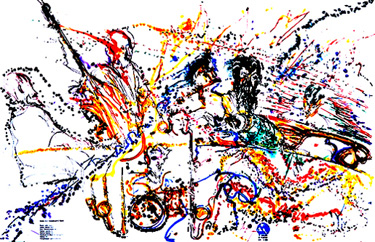 |
|
Nada |
Fusion welding of two world cultures was achieved live by Nada,
an octet featuring Finnish and South Indian musicians. Composer Eero
Hämeenniemi, founding member of the Korvat Auki! (Ears Open!)
Society, and Karaikudi R. Mani, master of the mridangam
two-headed drum, lead an ensemble in which listening together becomes
truly communicable. Markus Ketola on trap drums is well tuned
to beat cycles of the Karnatic tradition of India. Balasai
on wooden flute and Durgabrasad on gottuvadyam played
with a slide are just as responsive to the beautiful saxophonics of
Pentti Lahti. Brilliant colors of the Indian fabric covering
the platform onstage merged with a kaleidoscope of colors in the interwoven
musical sounds of Finland and India, manifesting joyful demonstration
that listening together in peace is a transcendent social experience.
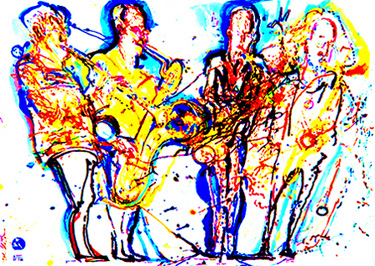 |
|
ROVA |
Rova Saxophone Quartet (Bruce Ackley—soprano,
Jon Raskin—baritone, Steve Adams—alto, Larry
Ochs—tenor) came together by the San Francisco Bay in 1977.
Fastidious interplay, adventurous programming, extensive touring and
recording have forged a unique force for saxophone possibilities in
contemporary music.
This listener was drawing at the Tin Palace in New York that same
year when Rova's contemporaries, the World Saxophone Quartet, played
their first concert. Documentation of the WSQ live continued through
the intervening time, especially during the tenure of the late,
great creative force, Julius Hemphill. Music Witness® loves
the saxophones. And only now, in Finland, do we learn that there
had once been an unrealized proposal to bring both Rova and the
WSQ together under a rubric to be arranged by Hemphill. Such a special
possibility for expansion is still a pleasure to contemplate. How
fortunate that Rova continues to mesh so beautifully and bring on
the development of its inimitable musical approach.
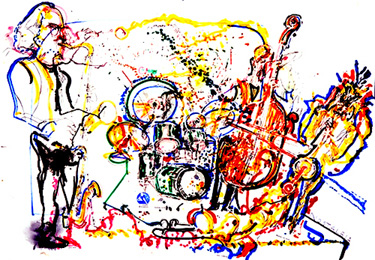 |
|
Nostalgia |
Nostalgia (accent on the first syllable in Finland) shows the
interacting ensemble composed by bassist John Lindberg featuring
four distinct musical voices: the always alert and authoritative Andrew
Cyrille on drums, Larry Ochs on tenor saxophone with room
to stretch his personal sound, and the unique attack of Wadada
Leo Smith's trumpet. Each is capable of stepping out and seizing
the time. A stunning set was slashed open on this night by brilliant,
visionary bursts of spirit-sound from Wadada's horn. Serious damage
was done to any preconceptions about limitations on musical expression.
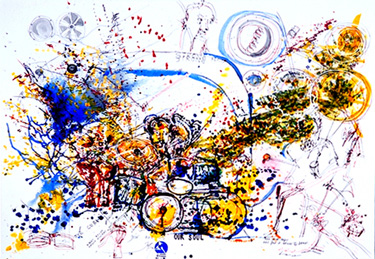 |
|
Our Soul |
Sunday afternoon saw a vast array of percussion instruments spread
across the broad stage. Trap drums, congas, djembes, bongos, timbales,
gongs, and racks of industrial gears, springs, and pierced castings
were ready as the first vocal callings and talking drum tones of Milford
Graves danced into view out of the darkness.
Soon the whole battery was roaring like a giant throbbing multi-colored
plane flying towards the audience, anchored by two bass drums driving
the bottom and the brilliant golden peal of the big ride cymbal
forcefully established and re-established at the top. Retreat was
impossible, so everyone present was drawn into a new level of awakening.
The drummer then transformed himself into a tumbling shaman at the
stage edge. Suddenly he was discovered seated in the audience with
everyone listening together to the mysterious vibrations still emanating
from the impregnated arsenal.
Quickly, before there was time to indulge in self-consciousness,
four audience members were drawn up onto the stage, each given a
different percussion instrument and a different personal rhythm.
With a little physical coaching from the Professor, they were soon
really leaning into their parts, a multiple complex rhythm was emerging,
and the great patterned plane was taking off again. This time the
audience itself was the engine roaring Forward (!!!) into a moment
of undeniable Healing-Transformation-Happening time.
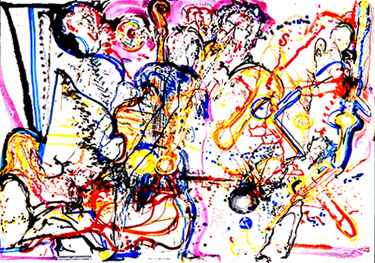 |
|
Inscape |
The Barry Guy New Orchestra played his recently composed, hour-long
structure "Inscape-Tableaux". With the composer conducting
from his magnificent bass, all-star colleagues from the UK, Sweden,
Switzerland, Germany, and the USA were coordinated, exhorted, challenged,
and listened to. The picture of what this Witness heard shows Marilyn
Crispell on grand piano on the left, Herb Robertson's trumpet
attacking from above, Barry Guy bowing into the extended trombone
of Johannes Bauer, and the frightening dexterity of Evan
Parker's saxophones. Across the back throb the doubled drums of
Paul Lytton and Raymond Strid, together with the tuba
of Per Åke Holmlander, the bass clarinets of Hans
Koch and, of course, at the lower right, Mats Gustafsson's
everting baritone saxophone. Intense. Probing. Tight. Together.
|
Jamit |
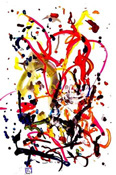 |
Jamit (Jam Session): The main stage show was over. The experienced
Happening crew was breaking down the lighting and sound equipment
as the chromatically stained hands of the music Witness® packed
up paints and portfolio. Yet another flavor of live music was still
approaching through the open doors at the reception in the Klubi just
beyond the back of the hall. It was a jam session, heard but unseen.
Last licks of color were thrown down before rinsing the brushes. Carrying
packed bags through the doors and into the party revealed Tony Buck
on stage again playing drums, driving another improvising vehicle
while Happening Director Annamaija Saarela was moving enthusiastically
with those dancing in celebration.
For the twentieth year in a row, the citizens of Tampere have invited
exciting musicians and excited listeners from around the world to
get together early in November at the center of their city. Getting
involved in really listening live to new sound expression, to each
other, among other enthusiastic listeners, fresh possibilities emerge.
Music, that fastest art, is always the first to show the way.
Korvat Auki ! Ears Open!
Rauha, a long weekend of listening to the musical sounds
of peace in Finland.
Kiitos. Thank you, once again, Tampere.
|
|
|
|
|

